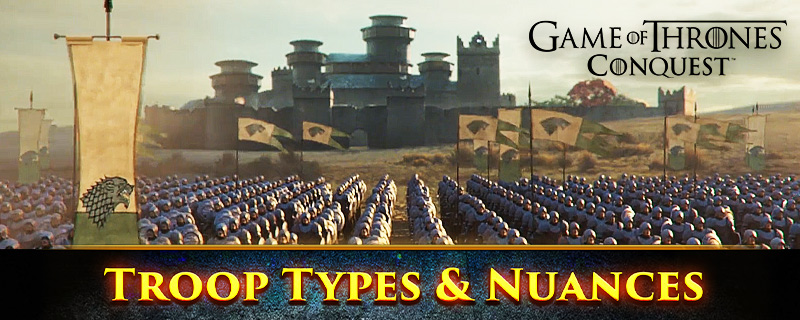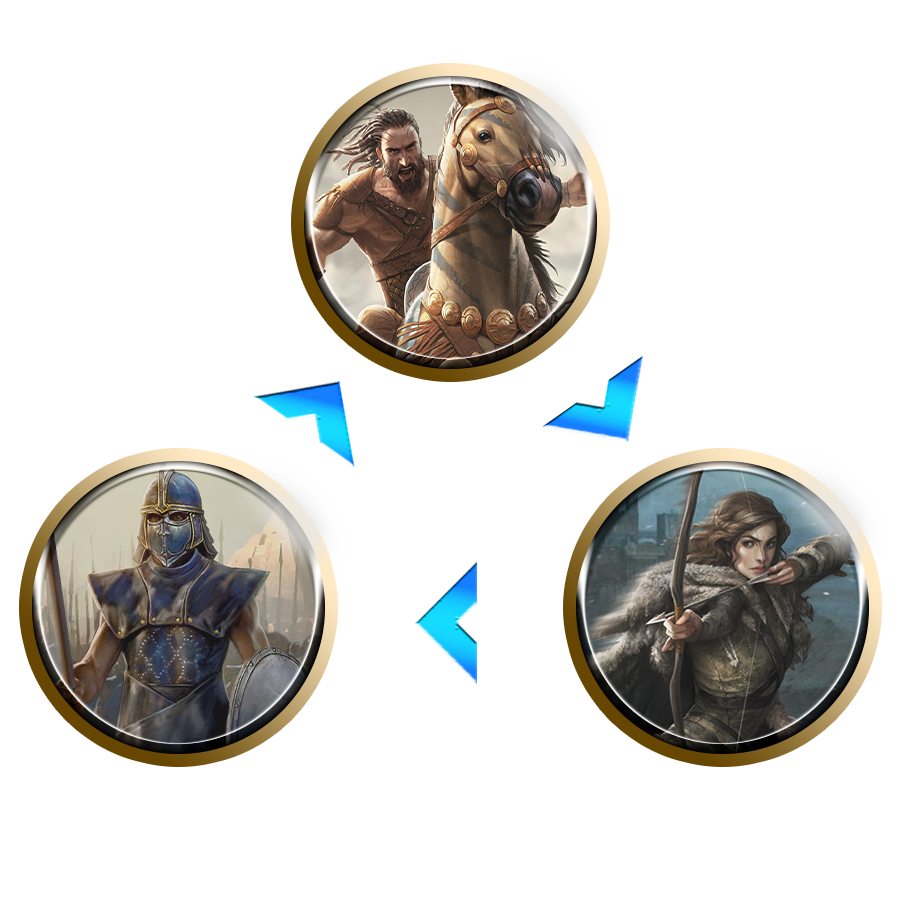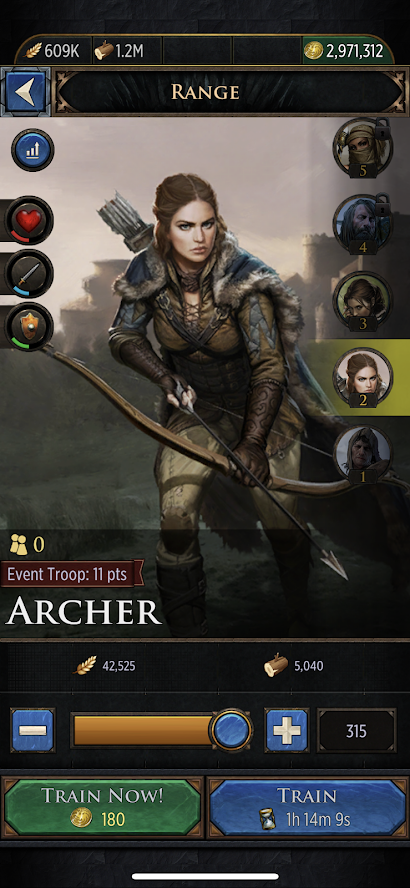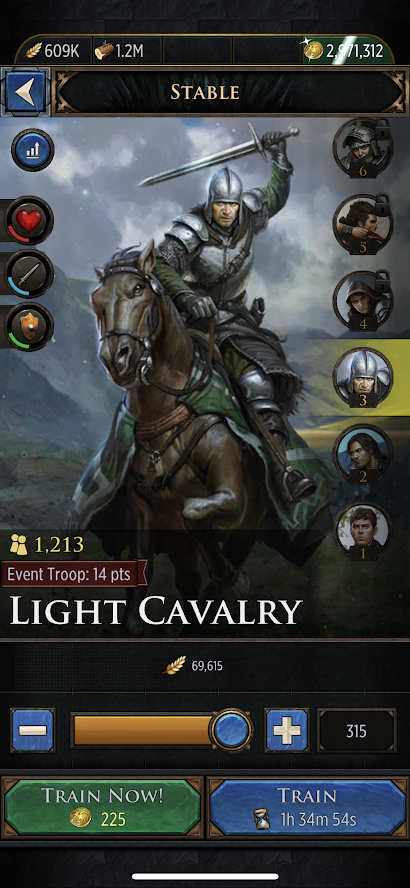
“If it is the swordsmen who rule us in truth, why do we pretend our kings hold the power?”
– Lord Varys
Guide Index
Troop Statistics
To learn more about your troops, take a look at the stats screen. You can find this by clicking any one of your troop training buildings, selecting a troop, and then pressing the stats button
![]() on the top left.
on the top left.
When you do, you’ll be greeted with this screen:

This screen lays out everything you need to know about the strengths, weaknesses, and capabilities of this particular troop type. The icons on the left break down the troop’s statistics, while the list at the bottom shows its traits.
Here are the different troop statistics, and what they mean:
Power  : This number is an overall estimate of the strength of the troop. This number is used as shorthand to compare the approximate combined strength of two opposing forces, but remember: This number does not take into account special bonuses, traits, or boosts that you (or your opponent) may have used! For example, the sell-sword above has the Fortitude trait, which gives him a bonus against cavalry. If the Sell-sword went up against a cavalry troop of the exact same power, the Sell-sword would still win.
: This number is an overall estimate of the strength of the troop. This number is used as shorthand to compare the approximate combined strength of two opposing forces, but remember: This number does not take into account special bonuses, traits, or boosts that you (or your opponent) may have used! For example, the sell-sword above has the Fortitude trait, which gives him a bonus against cavalry. If the Sell-sword went up against a cavalry troop of the exact same power, the Sell-sword would still win.
Attack  : This stat represents how much damage the troop can dish out in combat.
: This stat represents how much damage the troop can dish out in combat.
Defense  : This stat represents how well the troop can mitigate incoming damage.
: This stat represents how well the troop can mitigate incoming damage.
Health  : This stat represents how much damage the troop can withstand before being wounded, or dying.
: This stat represents how much damage the troop can withstand before being wounded, or dying.
Speed  : This stat affects both the speed that your troops march at, as well as how quickly they gather resources once they arrive.
: This stat affects both the speed that your troops march at, as well as how quickly they gather resources once they arrive.
Load  : This stat represents how many resources the troop can carry back from an expedition. Any time you send troops out to gather resources, or attack other players, you’ll need to make sure you send enough troops to carry back the resources you acquire.
: This stat represents how many resources the troop can carry back from an expedition. Any time you send troops out to gather resources, or attack other players, you’ll need to make sure you send enough troops to carry back the resources you acquire.
Range  : This stat represents the distance from which this troop can effectively fight. All Infantry will have a range of 1, but different archers might be able to fire from longer distances, and some cavalry have ranges greater than 1. Troops with a higher range tend to do more damage to troops with a lower one, and vice versa.
: This stat represents the distance from which this troop can effectively fight. All Infantry will have a range of 1, but different archers might be able to fire from longer distances, and some cavalry have ranges greater than 1. Troops with a higher range tend to do more damage to troops with a lower one, and vice versa.
Upkeep  : This stat represents how much food this troop depends on to stay active. An army marches on its stomach, after all, and soldiers need to eat.
: This stat represents how much food this troop depends on to stay active. An army marches on its stomach, after all, and soldiers need to eat.
Note: Any food that is contained in your Storehouse, or food that is still in boxes in your inventory, will not be consumed by your troops.
Wall Damage  : This stat represents the amount of damage this troop can do to the walls of a Keep. Only Siege troops can damage Keep walls. Every other troop type will always have a “Wall Damage” score of 0.
: This stat represents the amount of damage this troop can do to the walls of a Keep. Only Siege troops can damage Keep walls. Every other troop type will always have a “Wall Damage” score of 0.
Types of Troops
In Game of Thrones: Conquest there are a number of different types of troops, including Infantry, Ranged, and Cavalry. You can also make Siege and Trap troop types, and each one works a little differently.
Between the three main troop types (Infantry, Ranged, and Cavalry), each one is strong against one type and weak against the other, similar to a game of Rock Paper Scissors. The basic idea is that Infantry beats Cavalry, Cavalry beats Ranged, and Ranged beats Infantry.

There are a wide number of other factors that can have an effect on how combat plays out, but everything else being equal, when two armies of identical Strength face each other in combat, an army made of Infantry will beat an army made of Cavalry, and so on. Siege engines and Traps both exist outside of this dynamic—we’ll break those down further into the guide.
Tip: Game of Thrones: Conquest includes a huge number of ways to boost the effectiveness of your troops, including gear, talents for your Dragon, and research at the Maester’s Tower—not to mention consumable boosts. Because of this, it is helpful to decide early on which one or two of the troop types you want to focus your investments on.
Infantry

When you need to make your fellow Nobles come around to your way of thinking, a large group of burly men with swords goes a long way. Infantry troops have an innate advantage against Cavalry. They tend to be particularly strong defensively, although they also tend to have a low speed—this can make them a sub-optimal choice to send on missions to gather resources.
Ranged

Relying on a team of archers to best your opponents in battle is often more subtle and crafty than smashing them with hordes of infantry—but as any noble Lord or Lady knows, relying on subtlety has its limits. Ranged troops are particularly strong against Infantry, despite a tendency to have somewhat lower base Defense scores. Like Infantry, they tend to have lower Speed, but can make up for both with their bonus against Infantry and their wide variety of Gear options.
Cavalry

Cavalry troops are significantly faster and more mobile than other troops, which gives them an advantage in long marches or gathering missions—after all, the size of your army doesn’t matter if you can’t deploy them where you need them, when you need them. Cavalry also have strong base attack stats. They tend to be weak against Infantry, though, so be careful where and how you deploy them.
Siege Weapons

Siege weapons lie outside the “Rock-Paper-Scissors” dynamic of the three standard troop types. Siege weapons have extremely high Range, Health, and Load scores, but they also have a unique disadvantage against all other troop types—catapults and ballistae aren’t intended to be used against armies, after all. Siege weapons make up for this by being the only troops that are capable of damaging the actual walls of a Keep, and the only units capable of destroying Traps.
Traps

Traps aren’t technically troops—they can’t be sent on marches, and they can’t operate autonomously, but they share similar stats and are built in a similar way, so it’s important to include them here. Traps can only defend your Keep—they can’t be sent off to war—but a few well-placed Traps can do wonders on defense. When you’re attacked, Traps serve as Troops to defend your Keep. Each type of Trap can only damage one type of attacking Troop—Scalding Oil damages Infantry, Bolts damage Ranged, and Wood Spikes damage Cavalry.
Note: Even though Traps behave similarly to Troops when defending your Keep, they’re not soldiers and they can’t fight on their own. Your Traps can’t defend your Keep if there aren’t any Troops left to set them off!
Which troops should I use?
Because there are so many different ways to improve the capabilities of your troops in combat, it can be extremely helpful to choose to specialize where you want to invest your resources. Some careful research in the Maester’s Tower or a well-chosen piece of gear can make the difference between winning or losing a battle, and some of those upgrades require tremendous investment—so how do you choose which Troops you want to focus your efforts on?
- Pay attention to your Kingdom. With a little bit of investigation, you’re likely to find that there are more players in your Kingdom focusing on one type of Troop versus another. For instance, if you’re playing in a Kingdom with a large number of Cavalry-heavy players, you may be better-served to focus your attention on Infantry.
- Pay attention to your region. You’re likely to spend a lot of time tussling with other players near your Keep, so if you’re surrounded by players with Ranged-heavy armies, Cavalry may suit you well.
- Pay attention to your Allegiance. When you begin to cooperate with other players, it can be important to take into account the overall composition of the other players in your Allegiance. If your Allegiance has very few other players investing in Infantry, for example, a clever enemy might be able to take advantage of this. We’ll go into more detail about how you should be working with your Allegiance in our Importance of Allegiances guide.
- Pay attention to in-game Events. A changing roster of events can provide buffs and debuffs that can strongly affect the power of certain Troop types. Be sure to take into account which Events are ongoing and how long they’re expected to run.
- Be wary of over-specializing. If you invest all of your resources into making your Infantry stronger, a Ranged-heavy army will stop you in your tracks. Many players find it helpful to invest in two different types of soldiers at a time.
- Don’t be afraid to subdivide your armies. It might make sense to send an army of Cavalry out to gather resources, while saving your Infantry for a march on an enemy Keep.
“Who lives and who dies? Who will the swordsman obey? It’s a riddle without an answer, or rather, too many answers. All depends on the man with the sword.”
“And yet he is no one. He has neither crown nor gold nor favor of the gods, only a piece of pointed steel.”
“That piece of steel is the power of life and death.”
“Just so… yet if it is the swordsmen who rule us in truth, why do we pretend our kings hold the power?”
-Lord Varys discussing power with Tyrion Lannister

